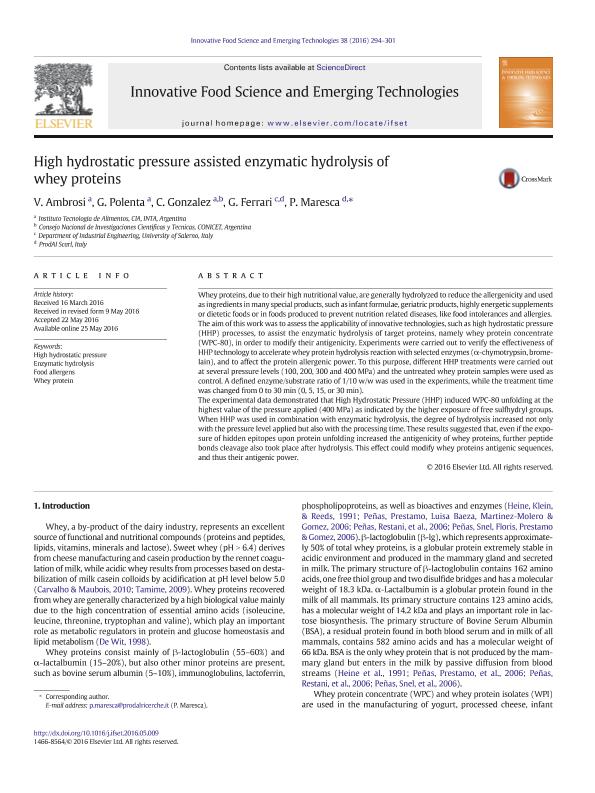Mostrar el registro sencillo del ítem
dc.contributor.author
Ambrosi, Vanina

dc.contributor.author
Polenta, Gustavo Alberto

dc.contributor.author
Gonzalez, Claudia Beatriz

dc.contributor.author
Ferrari, G.
dc.contributor.author
Maresca, P.
dc.date.available
2018-06-01T14:06:18Z
dc.date.issued
2016-12
dc.identifier.citation
Ambrosi, Vanina; Polenta, Gustavo Alberto; Gonzalez, Claudia Beatriz; Ferrari, G.; Maresca, P.; High hydrostatic pressure assisted enzymatic hydrolysis of whey proteins; Elsevier; Innovative Food Science & Emerging Technologies; 38; 12-2016; 294-301
dc.identifier.issn
1466-8564
dc.identifier.uri
http://hdl.handle.net/11336/46959
dc.description.abstract
Whey proteins, dueto their high nutritional value, are generally hydrolyzed to reduce the allergenicity and used as ingredients in many special products, such as infant formulae, geriatric products, high energy supplements or dietetic foods or in foods produced to prevent nutrition related diseases, like food intolerances and allergies. The aim of this work was to assess the applicability of innovative treatments, such as highhydrostatic pressure (HHP) processes, to assist the enzymatic hydrolysis of target proteins, such as whey protein concentrate (WPC-80), in order to modify their antigenicity. Experiments were carried out to verify the effectiveness of HHP technology to accelerate whey protein hydrolysis reaction with selected enzymes (á-chymotrypsin, bromelain), and to affect the protein allergenic power. For this purpose, different HHP treatments were carried out at several pressure level (100, 200, 300 and 400 MPa) and the untreated whey protein samples were used as control. A defined enzyme/substrate ratio of 1/10 w/w was used in the experiments, while the treatment time was changed from 0 to 30 minutes (0, 5, 15, or 30 min). The experimental data demonstrated that High Hydrostatic Pressure (HHP) induced WPC-80 unfolding,at the highest pressure level applied (400 MPa) as indicated by the high erexposure of free sulfhydryl groups. When HHP was combined with enzymatic hydrolysis, the degree of hydrolysis increased not only with the pressure level applied but also with the processing time. These results suggest that, even if the exposure of hidden epitopes upon protein unfolding increased the antigenicity of whey proteins, further peptide bonds cleavage also takes place after hydrolysis. This effect could modify whey proteins antigenic sequences, and thus their antigenic power.
dc.format
application/pdf
dc.language.iso
eng
dc.publisher
Elsevier

dc.rights
info:eu-repo/semantics/openAccess
dc.rights.uri
https://creativecommons.org/licenses/by-nc-sa/2.5/ar/
dc.subject
High Hydrostatic Pressure
dc.subject
Enzymatic Hydrolysys
dc.subject
Food Allergens
dc.subject
Whey Protein
dc.subject.classification
Alimentos y Bebidas

dc.subject.classification
Otras Ingenierías y Tecnologías

dc.subject.classification
INGENIERÍAS Y TECNOLOGÍAS

dc.title
High hydrostatic pressure assisted enzymatic hydrolysis of whey proteins
dc.type
info:eu-repo/semantics/article
dc.type
info:ar-repo/semantics/artículo
dc.type
info:eu-repo/semantics/publishedVersion
dc.date.updated
2018-05-31T14:40:12Z
dc.journal.volume
38
dc.journal.pagination
294-301
dc.journal.pais
Países Bajos

dc.journal.ciudad
Amsterdam
dc.description.fil
Fil: Ambrosi, Vanina. Instituto Nacional de Tecnología Agropecuaria; Argentina
dc.description.fil
Fil: Polenta, Gustavo Alberto. Instituto Nacional de Tecnología Agropecuaria; Argentina
dc.description.fil
Fil: Gonzalez, Claudia Beatriz. Consejo Nacional de Investigaciones Científicas y Técnicas; Argentina. Instituto Nacional de Tecnología Agropecuaria; Argentina
dc.description.fil
Fil: Ferrari, G.. Universita di Salerno; Italia. ProdAI Scarl; Italia
dc.description.fil
Fil: Maresca, P.. ProdAI Scarl; Italia
dc.journal.title
Innovative Food Science & Emerging Technologies

dc.relation.alternativeid
info:eu-repo/semantics/altIdentifier/doi/https://dx.doi.org/10.1016/j.ifset.2016.05.009
dc.relation.alternativeid
info:eu-repo/semantics/altIdentifier/url/https://www.sciencedirect.com/science/article/pii/S1466856416300868
Archivos asociados
